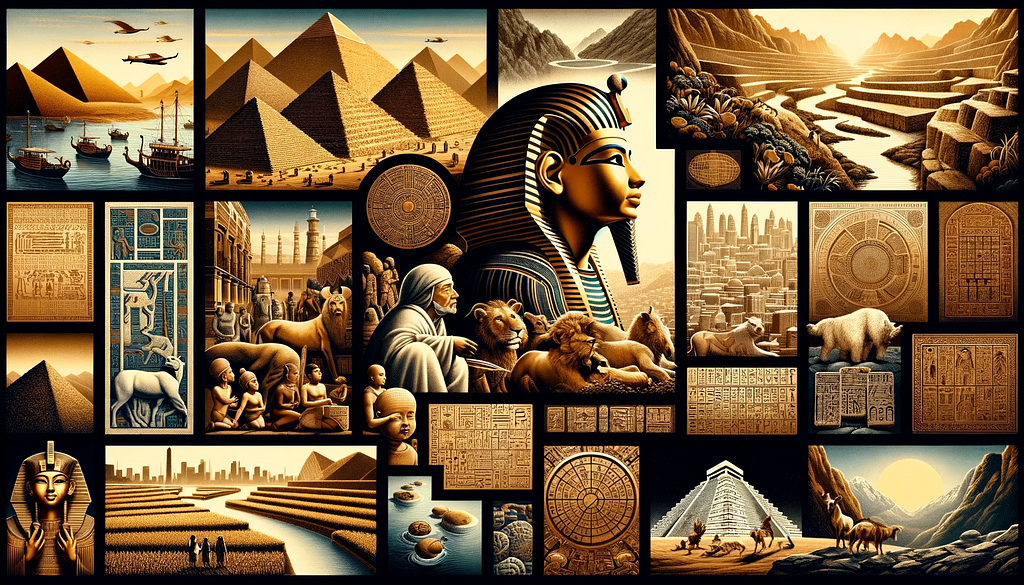
Ancient civilizations form the bedrock of human history, offering us a window into how our ancestors lived, worked, and interacted with their environment. From the fertile valleys of the Nile and the Tigris-Euphrates to the ancient cities of the Indus Valley and the bustling marketplaces of Mesoamerica, each civilization had its unique way of life. This article delves into the daily lives of people in various ancient civilizations, exploring their social structures, occupations, and cultural practices.
Life in Ancient Egypt
Social Structure and the Nile
Ancient Egyptian society was structured like a pyramid, with the Pharaoh at the top and farmers and slaves at the bottom. The Nile River was the lifeline of Egypt, its annual flooding ensuring fertile land for agriculture. This reliable source of water allowed Egyptians to grow surplus crops, which led to the development of trade and wealth.
Religion and Culture
Religion was central to Egyptian life. The Egyptians believed in an afterlife, constructing massive pyramids and tombs for their deceased. Art and architecture flourished, often featuring gods, goddesses, and pharaohs.
Life in Mesopotamia
The Cradle of Civilization
Often regarded as the cradle of civilization, Mesopotamia was located between the Tigris and Euphrates rivers. City-states like Babylon and Sumer were centers of trade and culture.
Society and Economy
Mesopotamian society was divided into several classes, including nobles, priests, merchants, and slaves. The economy was based on agriculture, but trade and craftsmanship also played significant roles. The invention of cuneiform script marked the beginning of recorded history.
Life in the Indus Valley
Urban Planning and Trade
The Indus Valley Civilization was remarkable for its advanced urban planning, with cities like Harappa and Mohenjo-Daro featuring grid layouts and sophisticated drainage systems. Trade, particularly in cotton, beads, and pottery, was a cornerstone of their economy.
Social Organization
Little is known about their social structure, but it is believed to have been egalitarian. The absence of large palaces or temples suggests a society that did not emphasize hierarchy.
Life in Ancient China
Dynastic Rule and Agriculture
Chinese civilization was characterized by successive dynasties. The majority of the population were peasants, engaged in rice farming. The Yellow and Yangtze rivers played crucial roles in agricultural development.
Philosophy and Inventions
Confucianism and Taoism shaped Chinese thought and culture. Ancient China is also known for its significant inventions like paper, the compass, and gunpowder.
Life in Mesoamerica
The Maya and Aztecs
The Maya and Aztecs were prominent civilizations in Mesoamerica. The Maya were known for their advanced writing system and astronomical knowledge, while the Aztecs are famous for their large city of Tenochtitlan and complex social structure.
Agriculture and Religion
Both civilizations relied heavily on agriculture, particularly maize cultivation. Religion was a central aspect, often involving rituals and human sacrifices.
The daily life in ancient civilizations was a complex interplay of social structures, economic activities, and cultural practices. While each civilization had its unique characteristics, common threads like the importance of agriculture, the influence of religion, and advancements in technology and trade run through them all. Understanding these ancient societies gives us valuable insights into the origins and evolution of human civilization.
This article provides a broad overview and can be expanded with more detailed information and examples for a more comprehensive understanding of each civilization.
Daily Life in Ancient Civilizations was originally published in SapiensStorytime on Medium, where people are continuing the conversation by highlighting and responding to this story.